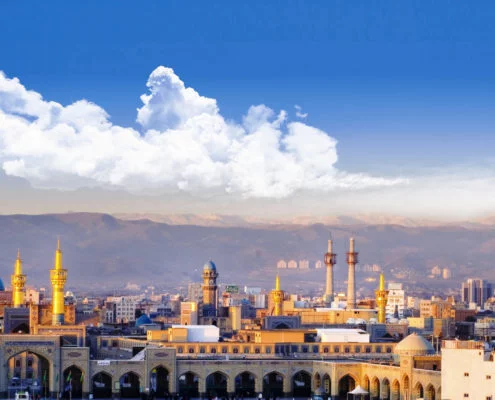Most of Islam’s sacred sites are in the Middle East, primarily in Saudi Arabia, Iran, and Iraq. Iran is home to numerous holy places and shrines of significant spiritual importance, attracting religious people from around the world. In this post, we delve into 7 top religious cities and sites in Iran to help you plan your religious travel itinerary.
Imam Reza Shrine: A Spiritual Haven in Mashhad
Mashhad, Iran’s second-most populous city located in the Razavi Khorasan Province of Northeast Iran, holds a revered status as the country’s holy city. Recognized as the cultural capital of the Islamic world in 2017, Mashhad welcomes millions of visitors annually, predominantly religious travelers. Known as Iran’s primary destination for “pilgrimage tourism,” Mashhad is home to the tomb and shrine of the eighth Shia Muslim Imam, Imam Reza. Pilgrims experience a spiritual journey known as Ziyarat, meaning “visiting,” to pay homage to Imam Reza.
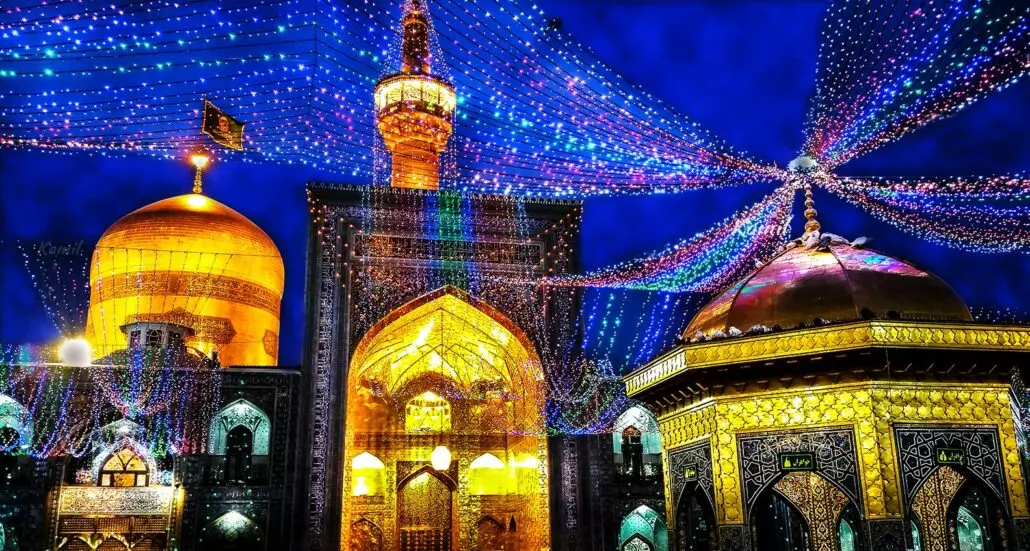
The monumental Imam Reza Shrine is the world’s largest mosque, attracting devout followers worldwide. Ziyarat in Mashhad mainly includes visits to three significant religious sites: the revered Imam Reza Holy Shrine, the exquisite Goharshad Mosque, and the historic Khaje Aba Salt Shrine. Goharshad Mosque, a masterpiece of Iranian art and traditional architecture, stands as a testament to the splendor of the Timurid dynasty, commissioned by Shah Rukh’s wife. Noteworthy is the “Maghsure Iwan,” an awe-inspiring yard adorned with inscriptions crafted by Goharshad’s son, reflecting the mosque’s historical significance. The third site, Khaje Aba Salt Shrine, commemorates Abasalt Haravi, a disciple of Imam Reza. You can explore the intricate beauty of this shrine through its four distinct doors, each adorned with diverse decorations embellished with seven-colored tiles.
Do You Need A Different Spiritual Experience?
Visit Our Iran will get you whatever you need. Email us at [email protected] or contact us through WhatsaApp icon at the bottom right of the page.
Qom: Holiness Beyond Measure
Qom, the capital of Qom Province and the seventh most populous city in Iran, has emerged as a sacred destination with a population exceeding one million. The pilgrimage in Qom centers around the revered Fatima Masumeh Shrine. Fatimah Bint Musa was the sister of the eighth Shia Muslim Imam in Mashhad. Notably, Qom has experienced rapid growth, doubling its population since the revolution in Iran. The city is renowned for its thriving Islamic educational institutions, specifically catering to Shia Islam.
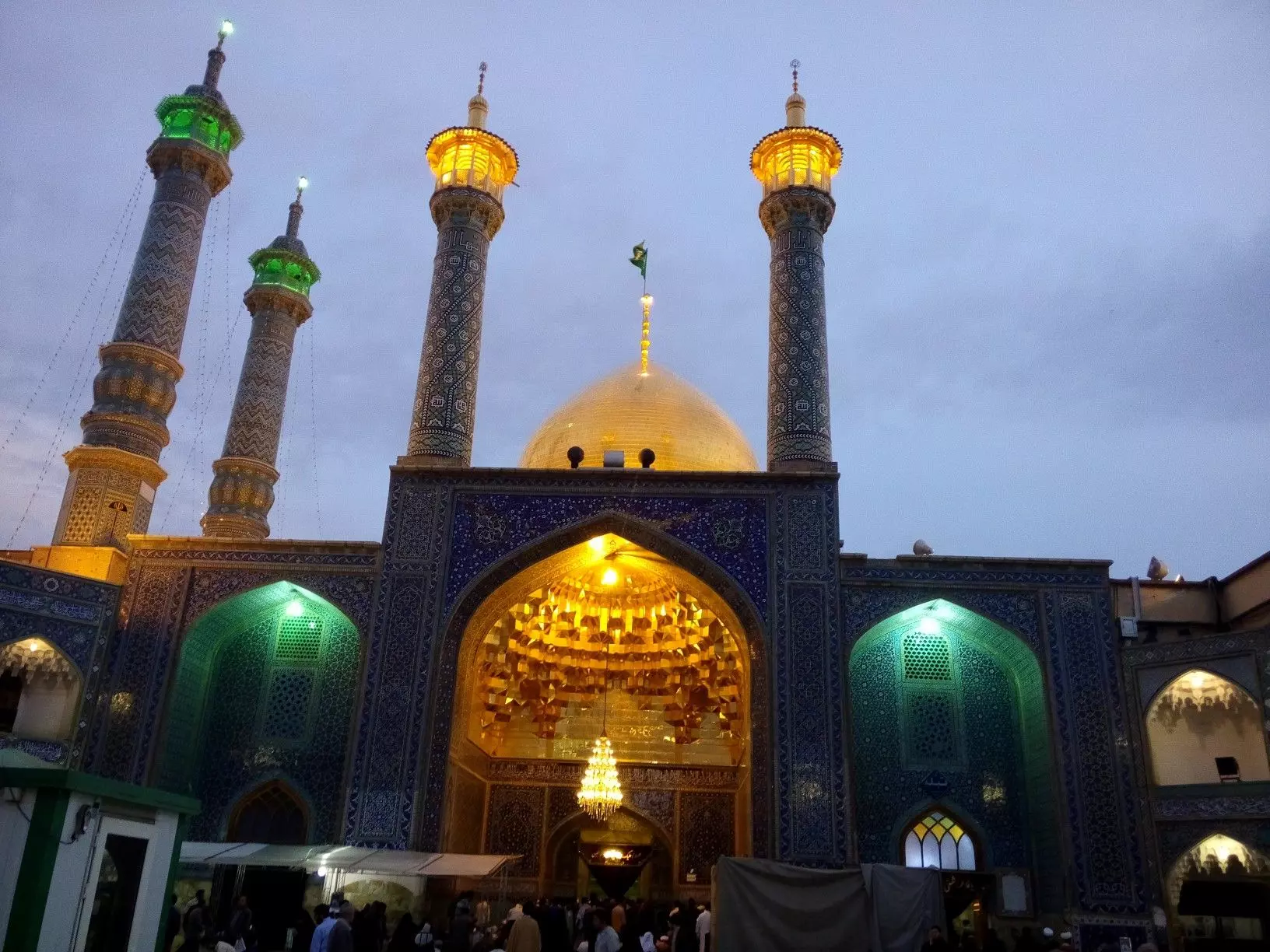
Pilgrimage and Prestige: Unveiling Qom’s Spiritual Gems
Pilgrims flock to Qom, drawn by revered sites such as Bait-un-Noor, where Masuma-e-Qom passed away. The city boasts the Ayatollah Marashi library, a treasure trove of ancient Islamic manuscripts, attracting seekers of profound knowledge. Chehel-E-Akhtataraan reveals the final resting place of forty Imamzadas, adding to the city’s spiritual allure. Additionally, tourists and the faithful alike are drawn to Bibi Shakeesa Tomb, honoring a lady who dedicated herself to serving the holy Imam. Delve into the spiritual tapestry of Qom, where every corner echoes with the resonance of Shia Islam’s rich heritage.
Shiraz: Where Faith Meets Splendor
Located in the southwest of Iran and serving as the capital of Fars province, Shiraz is the fifth most populous city with around 2 million inhabitants, making it a focal point for religious devotion. Explore the enchanting religious sites that adorn this city’s landscape, enhancing its cultural and spiritual allure.
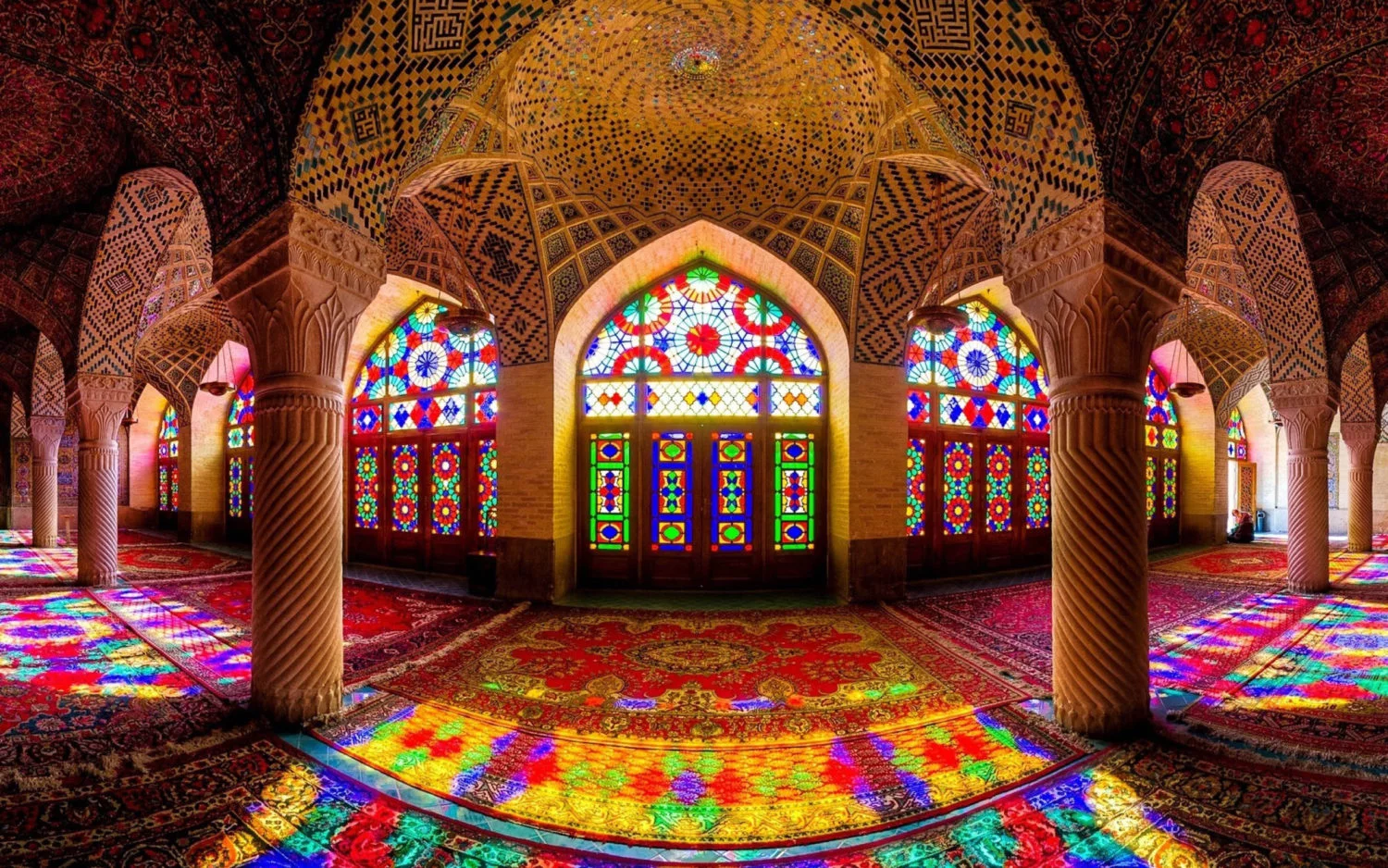
Shiraz’s Iconic Mosques and Mausoleums
Among Shiraz’s top five most beautiful religious sites, Nasir ol-Molk Mosque, fondly known as the Pink Mosque, mesmerizes visitors with its stunning stained-glass windows, vibrant tiles, and carpeted floors. Atigh Jame Mosque, also referred to as the Friday Mosque, invites pilgrims with its expansive courtyard and central cubic structure, offering a tranquil setting for prayer and reflection.
Imamzadeh-ye Ali Ebn-e Hamze and Shah-e Cheragh Mausoleum
Imamzadeh-ye Ali Ebn-e Hamze is a revered mausoleum and shrine in the city of Shiraz. Constructed to honor Ali Ebn-e Hamze, a beloved relative of Imam Reza, this site is renowned for its intricate mirrorwork adorning its walls and ceilings. Each year, it draws countless Shia Muslims who immerse themselves in pilgrimages to pay homage to Ali Ebn-e Hamze and seek spiritual solace within its sacred walls. The mausoleum houses the tomb of Ali Ebn-e Hamze, serving as a symbol of deep religious significance and devotion for visitors.
Similarly, the Shah-e Cheragh Mausoleum, also located in Shiraz, holds a prominent place in Iran’s religious landscape. This mausoleum is dedicated to brothers Ahmad and Muhammad, the sons of Musa al-Kadhim. As a masterpiece of Persian architecture, the Shah-e Cheragh Mausoleum captivates visitors with its stunning mirror mosaics and intricate design elements. Pilgrims from far and wide flock to this site, seeking blessings and spiritual fulfillment. It represents centuries of devotion and reverence, offering a space for prayer, reflection, and connection with the divine.
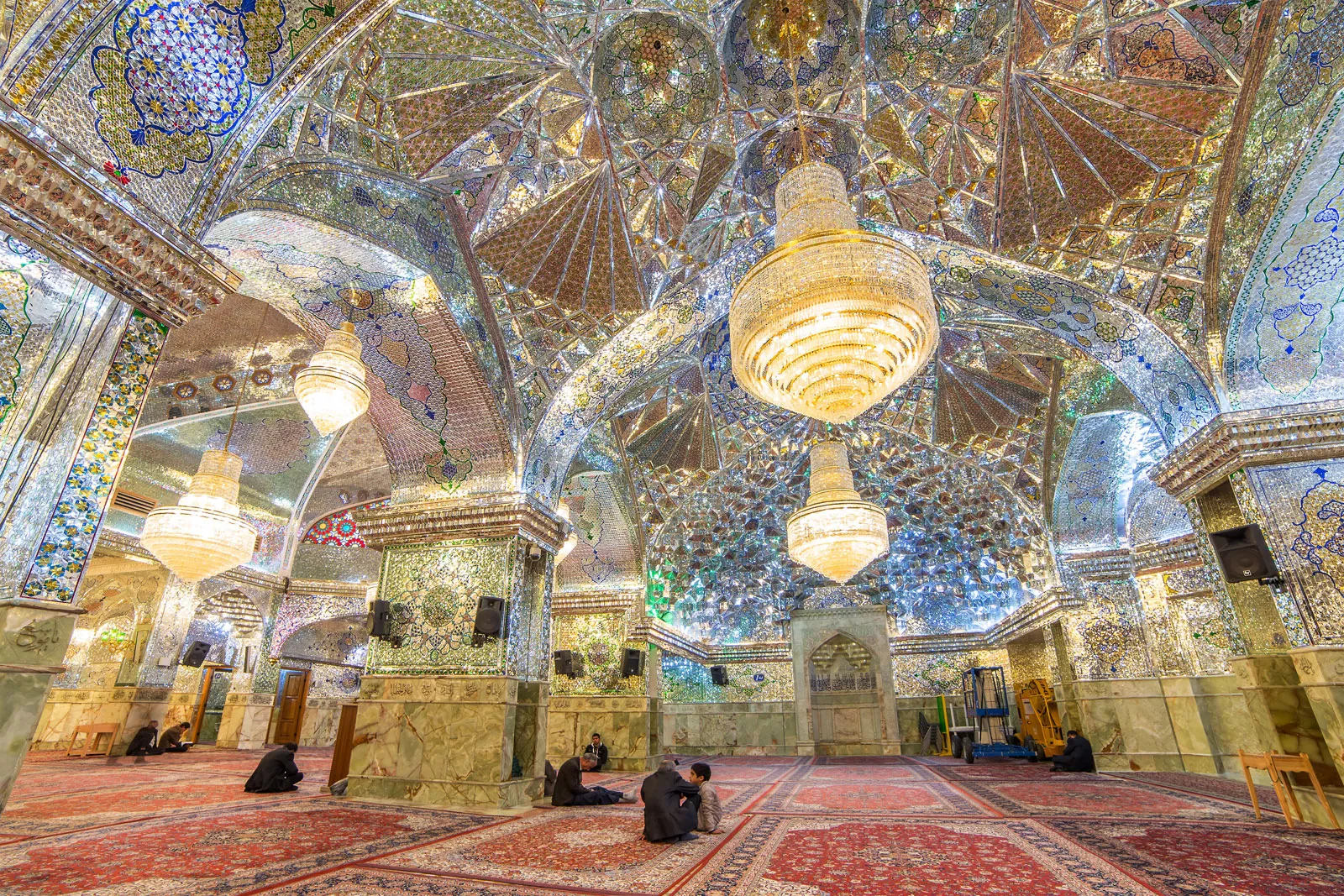
Yazd: Cradle of Zoroastrianism and Architectural Marvels
Located in the heart of the country, 270 km southeast of Esfahan, Yazd ranks as the fifteenth largest city in Iran, with over 1 million inhabitants. As an ancient city situated along the historic Silk Road, Yazd holds pivotal importance as both a significant center of Zoroastrianism and a prominent feature in the religious landscape.

Zoroastrian Pilgrimage and Architectural Heritage
Yazd shines as a beacon for Zoroastrians, with Ardakan and Mehriz being revered holy places that draw devotees from across the globe. Every year, hundreds of Zoroastrians undertake pilgrimages to these sacred sites, strengthening Yazd’s position as the birthplace of the Zoroastrian religion and a bastion of religious preservation efforts.
Yazd’s Architectural Treasures
Yazd boasts a wealth of architectural treasures that reflect its rich history and cultural heritage. The city’s distinctive skyline is adorned with elegant windcatchers, traditional Persian towers designed to capture and channel cooling breezes into buildings, offering respite from the desert heat. These iconic structures stand as a testament to Yazd’s ingenuity in adapting to its arid environment.
Additionally, Yazd is renowned for its intricate adobe buildings, constructed from sun-dried mud bricks and adorned with intricate geometric patterns and ornate tilework. These buildings, with their distinctive domes and vaulted ceilings, showcase the city’s architectural prowess and craftsmanship.
The Jameh Mosque of Yazd, dating back to the 12th century, is another architectural gem. Its grand iwan, intricate tilework, and towering minarets are a testament to the city’s rich Islamic heritage.
Moreover, the historic neighborhoods of Yazd, such as the Fahadan and Khan-e Lari districts, are a labyrinth of narrow alleys, traditional courtyards, and ancient mud-brick houses, offering visitors a glimpse into the city’s storied past.
Overall, Yazd’s architectural treasures stand as a testament to its rich history, cultural diversity, and enduring legacy as one of Iran’s most enchanting cities.
Towers of Silence and Commemorative Monuments
Yazd’s Towers of Silence, also known as dakhmas, are ancient funerary structures that hold significant cultural and historical importance. Perched on hilltops outside the city, these circular towers were traditionally used by Zoroastrians for the disposal of the dead in accordance with their religious beliefs.
The Towers of Silence served as open-air burial grounds where bodies were placed to be exposed to the elements and scavenging birds, such as vultures, as part of the Zoroastrian practice of sky burial. This practice aimed to prevent pollution of the earth, water, and fire, which were considered sacred elements in Zoroastrianism.
While no longer in use for their original purpose, the Towers of Silence remain a poignant reminder of Yazd’s Zoroastrian heritage and serve as a testament to the city’s cultural diversity.
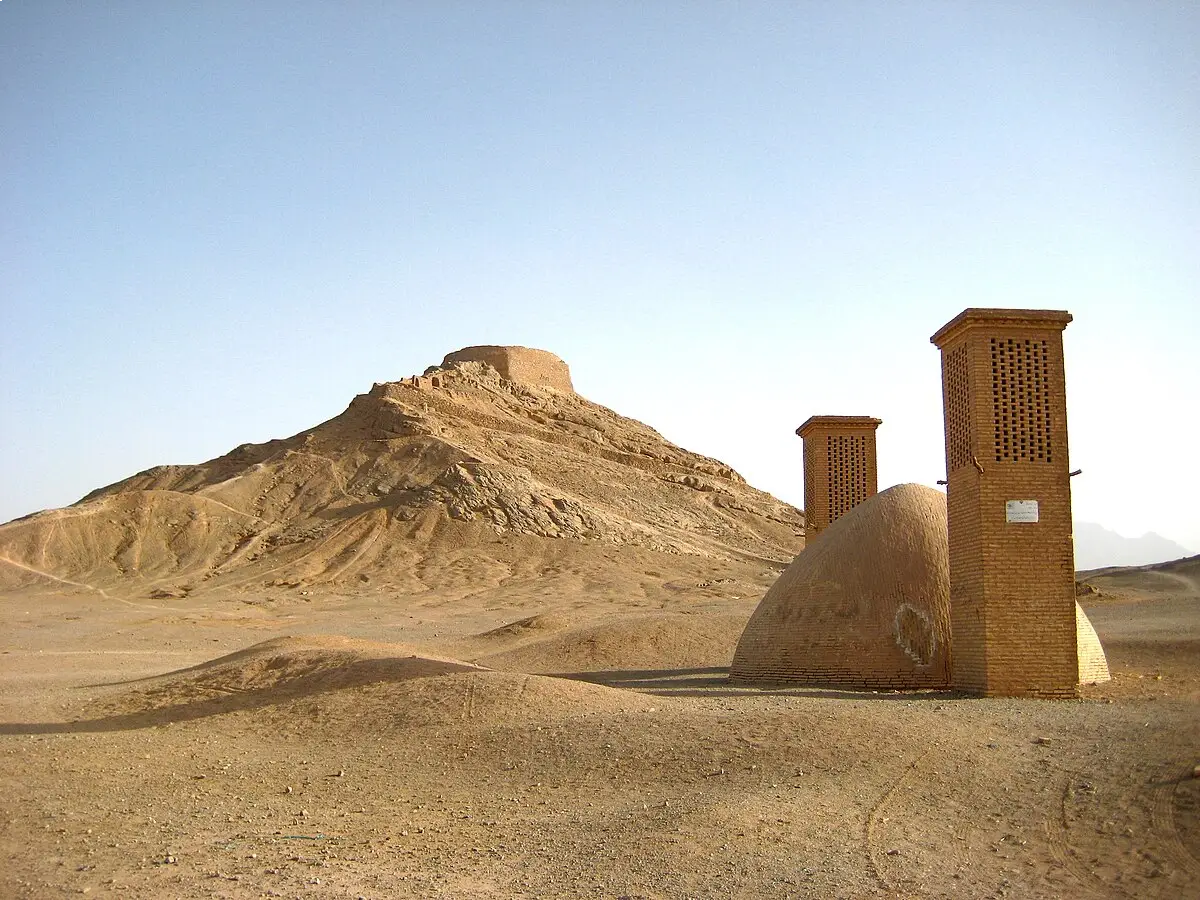
In addition to the Towers of Silence, Yazd is home to a number of commemorative monuments that honor significant figures and events in the city’s history. These monuments, ranging from elaborate mausoleums to simple plaques, are scattered throughout Yazd and offer insights into the city’s past.
One such monument is the Tomb of the 12 Imams, a sacred site revered by Shia Muslims, located in the heart of Yazd. This beautifully adorned mausoleum commemorates the twelve Shiite Imams, the spiritual leaders of the Shia faith.
In fact, Yazd’s Towers of Silence and commemorative monuments are integral parts of the city’s cultural landscape, providing a window into its rich history and religious traditions.
Dome of Grandeur: Seyed Rokn Addin Mausoleum
The Dome of Grandeur, also known as the Seyed Rokn Addin Mausoleum, is a magnificent architectural marvel located in Yazd, Iran. This historic mausoleum is dedicated to Seyed Rokn Addin, a revered figure in Yazd’s history.
The mausoleum features a striking dome, adorned with intricate tilework and geometric patterns, which dominates the skyline of Yazd. Its elegant proportions and exquisite craftsmanship make it a masterpiece of Persian architecture.
Within the mausoleum, visitors can explore a serene sanctuary adorned with ornate decorations and calligraphy, creating a sense of reverence and tranquility. The interior is illuminated by stained glass windows, casting a warm and ethereal glow over the space.
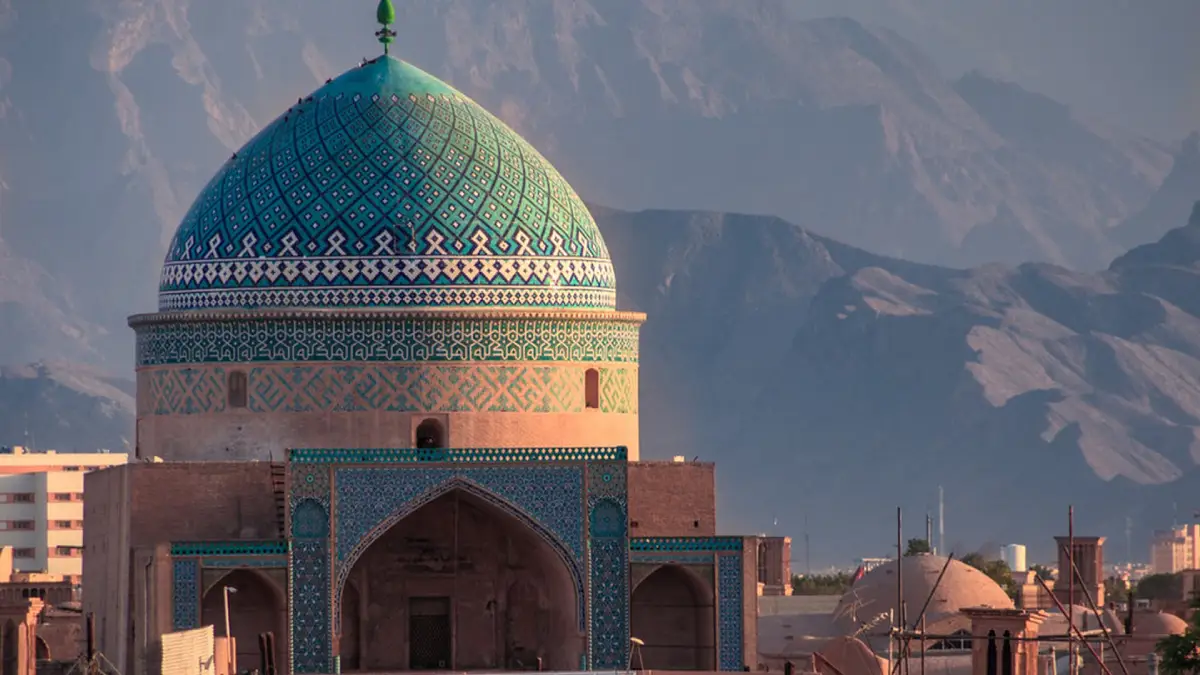
The Seyed Rokn Addin Mausoleum serves as a place of pilgrimage and contemplation for both locals and visitors alike. It is a testament to the rich cultural heritage and religious devotion of the people of Yazd.
Overall, the Dome of Grandeur stands as a symbol of Yazd’s grandeur and architectural prowess, inviting visitors to admire its beauty and reflect on the spiritual significance of this historic monument.
Chak Chak: A Sanctum of Zoroastrian Spirituality
Chak Chak, a serene village near Kharanaq in Yazd, is a sacred site resonating with the ancient echoes of Zoroastrianism, the oldest monotheistic faith. This village holds profound significance, drawing pilgrims and visitors especially during special days, particularly from the 14th to the 18th of June, as Zoroastrians gather to honor their beliefs.
Legend has it that Chak Chak was the refuge of the last Persian princess, Nikbanou, who sought sanctuary from pursuing Arabs. Her prayers to Ahura Mazda were answered with a miraculous mountain, now the shrine, providing sanctuary, with the name Chak Chak echoing the tears shed by Nikbanou.
Despite its sparse population, Chak Chak attracts pilgrims and tourists alike, enticed not only by the holy sites but also by the profound beauty of the temple that encapsulates centuries of spiritual devotion. This village stands as a testament to the endurance of faith and the resilience of Zoroastrian traditions, inviting all who visit to witness the convergence of history, spirituality, and natural beauty in this hallowed corner of central Iran.
Isfahan: A Tapestry of Faith and Persian Grandeur
Nestled in the heart of Iran, Isfahan emerges as the third-most populous city, boasting over 2 million residents and earning its reputation as a revered sanctuary within the country. Renowned for its exquisite Persian architecture, the city mesmerizes visitors with its stunning array of bridges, palaces, tiled mosques, minarets, and grand boulevards, each adding to its allure as a cultural and religious epicenter.
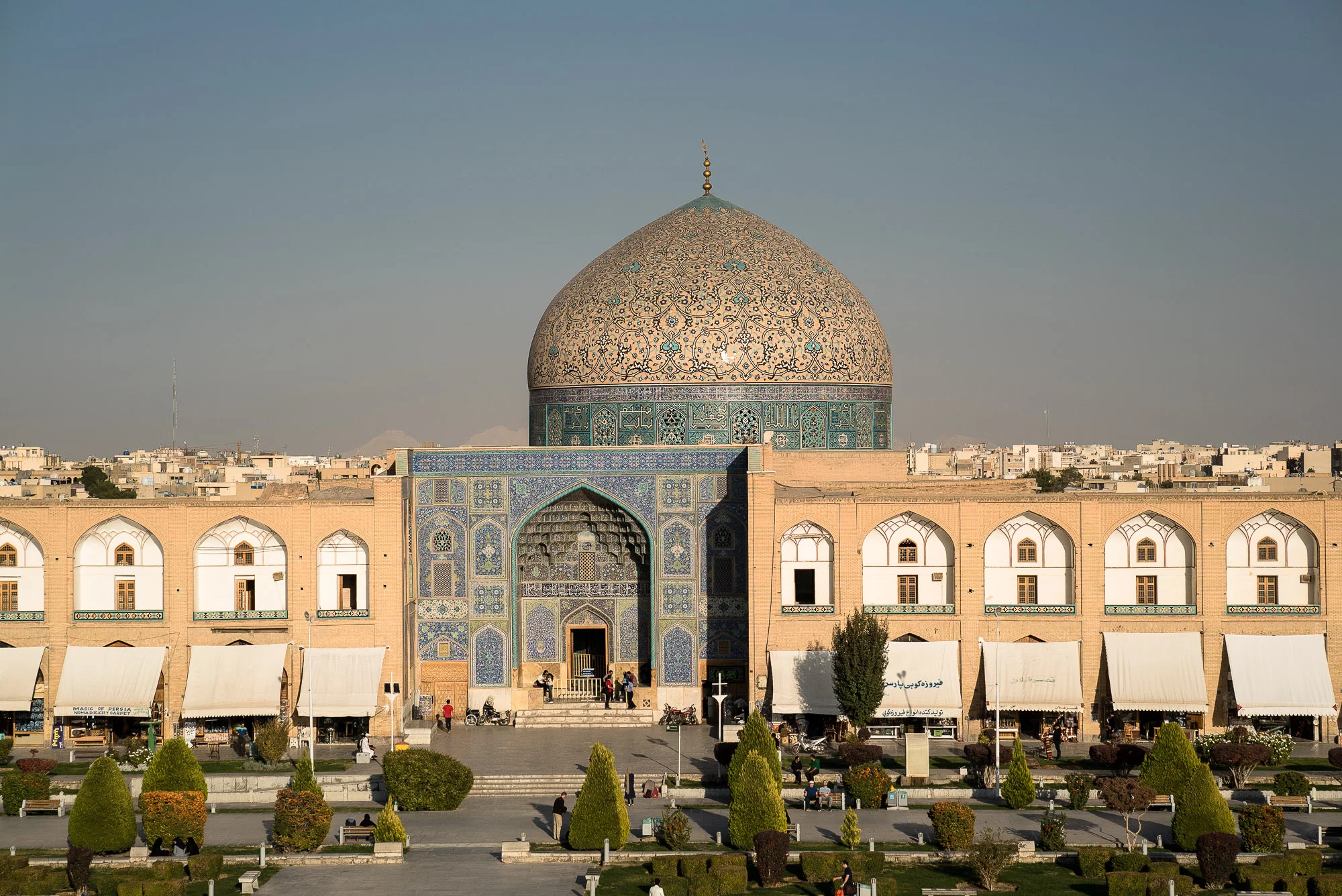
Architectural Marvels and Religious Sanctuaries
Isfahan’s religious heritage draws countless visitors worldwide, keen to discover its ancient buildings, artifacts, and monuments. At its core lies Naqshe Jahan Square (Shah Square), also called Meidan Emam, a UNESCO World Heritage site and a cherished Iranian landmark. The architectural marvels of Sheikh Lotfollah Mosque, a Safavid Empire gem, and Shah Mosque, towering in the square’s eastern corner, enhance the city’s religious charm.
Jameh Mosque and the Shah Mosque
The Jameh Mosque, also known as the Friday Mosque, is a masterpiece of Islamic architecture that dates back to the 8th century. It has undergone numerous renovations and expansions over the centuries, resulting in a stunning blend of architectural styles, including Seljuk, Mongol, Ilkhanid, and Safavid. The mosque’s towering minarets, intricate tilework, and expansive courtyards make it a must-visit destination for travelers seeking to immerse themselves in the rich cultural heritage of Isfahan.
On the other hand, the Shah Mosque, also called the Imam Mosque, is a magnificent example of Safavid architecture and one of the most stunning mosques in Iran. Built during the reign of Shah Abbas I in the early 17th century, the mosque is renowned for its towering dome, intricate tilework, and majestic entrance portals. Its majestic beauty is further enhanced by the serene atmosphere of its prayer halls and courtyards, making it a spiritual oasis in the heart of Isfahan.
Both the Jameh Mosque and the Shah Mosque serve as important religious and cultural landmarks in Isfahan, attracting visitors from around the world with their architectural splendor and historical significance.
Zoroastrian Fire Temple: Echoes of Ancient Persia
Atashgah, also known as the Fire Temple, is a sacred site in Isfahan that holds deep historical and religious significance. Dating back to the Sassanian era, Atashgah served as a Zoroastrian fire temple, where eternal flames were kept burning as a symbol of worship to Ahura Mazda, the Zoroastrian god of fire. The temple’s architectural design, characterized by its domed roof and intricate tilework, reflects the rich cultural heritage of ancient Persia. Today, Atashgah continues to attract visitors who come to pay homage to Zoroastrianism, explore its ancient ruins, and learn about the religious practices of Iran’s pre-Islamic era.
Visitors to Atashgah can experience a sense of tranquility and reverence as they explore the temple’s grounds and witness the eternal flame that still burns within its walls. Surrounding the temple, lush gardens and scenic vistas provide a serene backdrop for contemplation and reflection. The site serves as a cultural and educational hub, offering insights into the history and traditions of Zoroastrianism, as well as its enduring legacy in modern-day Iran. As a symbol of Iran’s rich religious tapestry, Atashgah stands as a testament to the country’s diverse cultural heritage and spiritual significance.
Hakim Mosque: A Revered Oasis of Worship
Hakim Mosque stands as a testament to the city’s rich architectural heritage and religious significance. Dating back to the 17th century, this historic mosque is renowned for its intricate tilework, soaring minarets, and majestic domes, which showcase the exquisite craftsmanship of the Safavid era. Named after the renowned physician and scholar Hakim Muhammad ibn Mahmud Amuli, the mosque served not only as a place of worship but also as a center for intellectual and cultural exchange. Today, Hakim Mosque continues to captivate visitors with its stunning beauty and spiritual ambiance, offering a glimpse into Isfahan’s illustrious past and serving as a cherished symbol of Iran’s architectural legacy.
Tehran: Exploring Spiritual Splendors in the Capital
Tehran, the vibrant capital of Iran, is one of the largest and most popular cities, located in the north-central region. Besides its bustling urban life, Tehran offers a plethora of historical and religious treasures that attract visitors from far and wide.
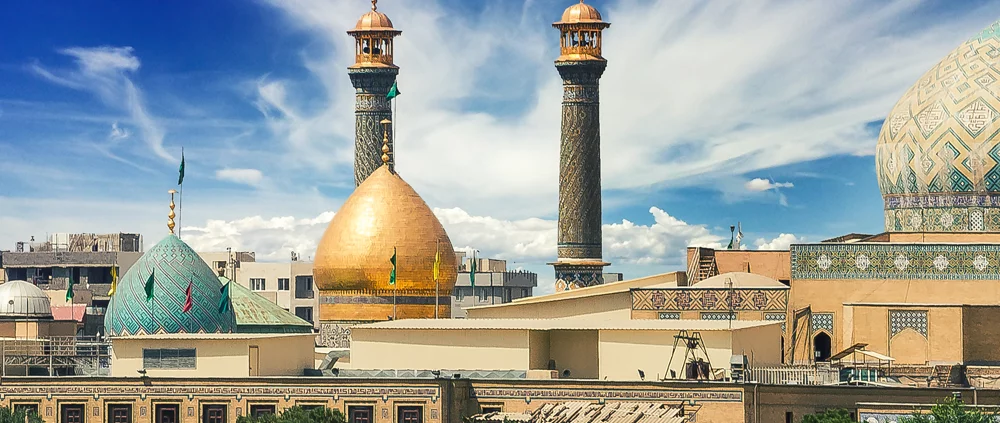
The Shah Abdul Azim Shrine
The Shah Abdul Azim Shrine, located in southern Tehran, is a revered pilgrimage site dedicated to Shah Abdul Azim, a descendant of Imam Hasan, the grandson of Prophet Muhammad. This sacred complex comprises a mausoleum, mosque, and traditional Persian gardens, attracting both Shia Muslims and visitors seeking spiritual solace. The shrine’s exquisite architecture, adorned with intricate tilework and Persian calligraphy, provides a serene sanctuary for prayer and reflection.
Imamzadeh Saleh Shrine
Imamzadeh Saleh, located in Tajrish, a northern district of Tehran, is a revered shrine dedicated to Saleh, a descendant of Imam Musa al-Kadhim. This holy site attracts pilgrims and visitors seeking blessings and solace, with its ornate domes, mirrored halls, and serene courtyards. The shrine’s tranquil atmosphere and spiritual significance make it a cherished destination for those seeking spiritual enlightenment and divine intervention in their lives.
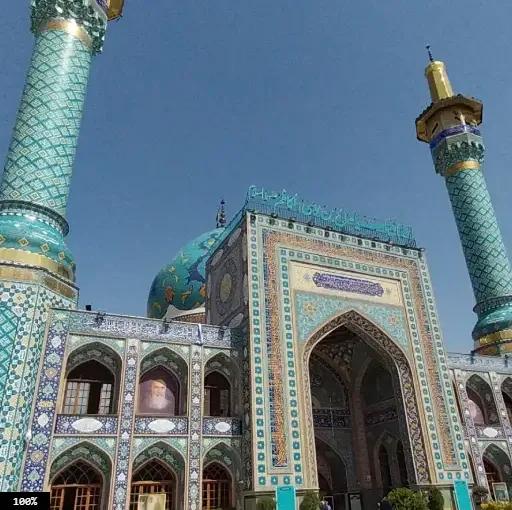
Mosalla Mosque Complex
The Mosalla Mosque Complex, situated in the heart of Tehran, is one of the largest prayer venues in Iran and a prominent symbol of Islamic architecture. With its vast prayer halls, towering minarets, and intricately designed domes, the complex provides a majestic setting for congregational prayers and religious gatherings. Visitors can witness the devout worshippers and immerse themselves in the spiritual ambiance of this revered mosque.
The Zoroastrian Ateshkadeh
The Zoroastrian Ateshkadeh, situated in Rey, a suburb of Tehran, is one of the most significant fire temples in Iran and holds immense religious importance for followers of Zoroastrianism. Dating back to the Sassanian era, this ancient sanctuary houses an eternal flame symbolizing the Zoroastrian deity Ahura Mazda. Visitors can immerse themselves in the rich history and rituals of Zoroastrianism while admiring the temple’s architectural grandeur and tranquil surroundings.
St. Sarkis Cathedral and Zurkhaneh-ye Ayatollah Taleghani
St. Sarkis Cathedral and Zurkhaneh-ye Ayatollah Taleghani, located in the heart of Tehran, represent a unique blend of Christian and Iranian cultural heritage. St. Sarkis Cathedral, an Armenian Apostolic church, stands as a testament to Tehran’s diverse religious landscape, while the adjacent Zurkhaneh-ye Ayatollah Taleghani serves as a traditional Iranian gymnasium and a center for spiritual practices. This juxtaposition of faiths and traditions reflects Tehran’s multicultural identity and spirit of religious tolerance.
Embrace Spiritual Diversity and Heritage
Iran’s religious sites offer a captivating journey through centuries of spiritual devotion, cultural heritage, and architectural marvels. From the majestic mosques and shrines of Mashhad and Qom to the ancient fire temples of Yazd and the tranquil villages like Chak Chak, each destination embodies the rich tapestry of Iran’s religious diversity.
Whether you seek solace, historical insight, or simply wish to immerse yourself in the spiritual ambiance, Iran’s sacred sites promise an unforgettable experience. We invite you to explore these sacred sites and discover the profound beauty and significance they hold. If you’re ready to experience this spiritual journey, visit our Ziyarat tour page to plan your pilgrimage and experience the wonders of Iran’s religious heritage firsthand.
